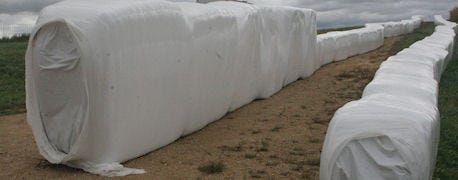May 29, 2014

By Dan Undersander
Baleage is a practical method to harvest and store either wet hay or to make haylage. If the harvested forage is less than 50% moisture, preservation is primarily by maintenance of anaerobic (oxygen limiting) conditions and, if harvested forage is 50% to 70% moisture, preservation is due both to anaerobic conditions and acids produced in the fermentation.
Garbage in, garbage out

Wrapping bales is an effective method of preserving wet hay.
First, recognize that no forage preservation method can improve the quality of forage; some quality is always lost in the harvesting process. Therefore, when making baleage, harvest the forage slightly at higher quality than desired for the animals being fed. From harvest to storage, if good harvesting practices are in place, expect a 5% to 10% decline in quality for haylage and 10% to 15% decline in quality for hay. So harvest alfalfa at the mid-bud stage (or 29 inches on first cutting whichever is first) and grass at the boot stage for milking dairy cows. For beef, sheep and other growing animals, harvest alfalfa at 10% flower and grass at early heading.
Next mow, condition and put into a wide swath (covering at least 70% of the cut area). This increases the initial drying rate and reduces carbohydrate (NFC) loss to continued plant respiration.
Thirdly, make bales (either square or round) as dense as possible. This allows more dry matter in the same storage volume. More importantly, it reduces the oxygen content in the bale and reduces plant and microbial respiratory loss to dry matter and forage quality after baling and wrapping.
Wrapping bales as soon after baling as possible reduces the heating damage. Bales wrapped immediately after baling never got has hot as unwrapped bales, generally remaining below 100 degrees. Bales wrapped 24 hours after baling were already at 130 degrees when wrapped.
Preventing mold
In another study, we looked at the number of wraps with plastic necessary to prevent mold growth and heating. Standard plastic is 1 mil thick. There are some plastic quality differences and it is recommended to stay away from the cheapest plastic. Temperatures above ambient (about 80 degrees) in figure 2 indicate the oxygen was penetrating the plastic and allowing the microbes to grow and produce heat. The data indicates that at least six wraps of 1 mil plastic was necessary to prevent air (oxygen) movement into the bale. This would be true for individually wrapped bales or those wrapped in-line.
A few additional thoughts about making baleage:
•Lactobacillus inoculant is not recommended for baleage since it must be sprayed onto the top of the windrow as the hay is entering the baler. Lactobacillus bacteria are only effective when coverage is good (i.e. that is why the recommendation is to apply at the chopper). Since coverage will be minimal in baleage making, the inoculant is likely to have little effect.
•Hay preservative is not recommended as it should not be necessary if the bale is wrapped properly. Note that an advantage of wrapped bales over preservative treated wet hay is that forage at any moisture content can be wrapped and preserved while preservative must be applied in relation to the moisture content of the hay to be effective. So moisture variation of hay within or among fields is no problem.
•Use of a cutter on the front of the baler is recommended to cut the hay into 4-inch lengths. This allows greater packing density, eases use in a TMR (and reduces energy required), and/or reduces feeding losses from a feeder.
In summary, wrapping bales is an effective method of preserving wet hay. It can also produce high quality haylage equal to that chopped into tubes or bunkers. The decision of which method to use for haylage should depend on herd size with wrapped bales being very cost effective for small herds (less than 150 animals) and less efficient for larger herds.
Undersander is a University of Wisconsin Extension agronomist.
You May Also Like




